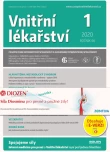A few notes from reading of the 2019 dyslipidemia guidelines
Authors:
Michal Vrablík
Authors‘ workplace:
3. interní klinika 1. LF UK a VFN, Praha
Published in:
Vnitř Lék 2020; 66(1): 52-59
Category:
In Brief
Overview
In September 2019, European companies presented new recommendations for dyslipidemia management. In October they were followed by a brief Statement of the Committee of the Czech Society for Atherosclerosis, which adheres to the principles of the new guidelines and brings comments to these. The recommended procedures summarized the rapidly accumulating knowledge of the importance of dyslipidemia in the field of atherosclerotic cardiovascular disease (ASCVO). It summarized recommendations for the diagnosis of disorders of plasma lipid metabolism. The stratification of risk categories was added and refined, to which the extreme risk category was added. Newly adjusted (reduced) target values for all risk categories except low risk. A new recommendation is the reduction of atherogenic lipid concentrations, led by intensive hypolipidemic pharmacotherapy, the review of which provides recommendations. The main requirement for clinical practice will now be the implementation of guidelines into practice. This objective should also serve this brief commentary on the first observations with the work with new recommendations
Keywords:
Atherosclerosis – dyslipidemia – cardiovascular risk – guidelines – hypolipidemics
Sources
1. Mach F, Baigent C, Catapano AL et al. ESC Scientific Document Group. 2019 ESC/EAS Guidelines for the management of dyslipidaemias: lipid modification to reduce cardiovascular risk. Eur Heart J 2019; pii: ehz455. doi: 10.1093/eurheartj/ehz455.
2. Vrablík M, Piťha J, Blaha V et al. Stanovisko výboru České společnosti pro aterosklerózu k doporučením ESC/EAS pro diagnostiku a léčbu dyslipidemií z roku 2019. Atheroreview 2019, 4(3): 126–137.
3. Soška V, Karásek D, Blaha V et al. Souhrn konsenzu EAS týkajícího se kauzálního vztahu mezi lipoproteiny o nízké hustotě a aterosklerotickými kardiovaskulárními onemocněními zpracovaný výborem České společnosti pro aterosklerózu. Vnitr Lek. 2019; 64(12): 1124–1128.
4. Vrablík M, Freiberger T, Blaha V, Soška V, ČEŠKA R. Souhrn konsenzu panelu expertů European Atherosclerosis Society k otázce diagnostiky a klinickému vedení nemocných s familiární hypercholesterolemií. Hypertenze a KV prevence, 2015, 4, p. 44–48.
5. Catapano AL, Graham I, De Backer J et al. 2016 ESC/EAS Guidelines for the Management of Dyslipidaemias. Eur Heart J 2016; 37: 2999–3058.
6. Townsend N, Lauren Wilson1, Prachi Bhatnagar et al. Cardiovascular disease in Europe: epidemiological update 2016European Heart Journal (2016) 37, 3232–3245.
7. Bangalore S, Fayyad R, Kastelein JJ et al. 2013 Cholesterol Guidelines Revisited: Percent LDL Cholesterol Reduction or Attained LDL Cholesterol Level or Both for Prognosis? Am J Med. 2016 Apr; 129(4): 384–391.
8. Sabatine MS, Giugliano RP, Wiviott SD et al. Efficacy and safety of evolocumab in reducing lipids and cardiovascular events. N Engl J Med 2015; 372: 1500–1509.
9. Schwartz GG, Steg PG, Szarek M et al. Alirocumab and Cardiovascular Outcomes after Acute Coronary Syndrome. N Engl J Med 2018; 379: 2097–2107.
10. Češka R, Táborský M, Vrablík M. Společné stanovisko odborných společností k preskripci PCSK9 inhibitorů. Vnitr Lek. 2019; 64(12): 1131–1136.
11. Bhatt DL, Steg PG, Miller M et al; REDUCE -IT Investigators. Cardiovascular Risk Reduction with Icosapent Ethyl for Hypertriglyceridemia. N Engl J Med. 2019 Jan 3; 380(1): 11–22.
Labels
Diabetology Endocrinology Internal medicineArticle was published in
Internal Medicine

2020 Issue 1
Most read in this issue
- Sarcopenic obesity – current view
- Chronic stress, mental discomfort, and depression increase the rates of infectious, autoimmune as well as malignant diseases
- Odešel velký člověk a lékař prof. MUDr. Vítězslav Kolek, DrSc., FCCP
- Mandibular pain and deformation as a presentation of fibrous dysplasia of the mandible
